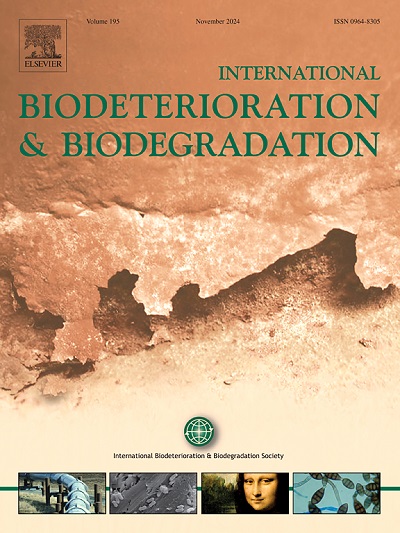Reassessing of enzymes degrading mycotoxins at acidic pH
IF 4.1
2区 环境科学与生态学
Q2 BIOTECHNOLOGY & APPLIED MICROBIOLOGY
International Biodeterioration & Biodegradation
Pub Date : 2025-02-01
DOI:10.1016/j.ibiod.2024.105994
引用次数: 0
Abstract
Mycotoxins contaminate different commodities, thus endangering well being of humans and animals. In the present study, three enzymes – peroxidase, laccase, and glucose oxidase – were reanalyzed using computer modeling for their catalytic activity at acidic pH in a sample group of 18 mycotoxins. Fungal glucose oxidase was found to be catalytically active with the largest number of mycotoxins tested in silico according to results of molecular docking, and was further selected for in vitro experiments. Initially glucose oxidase activity was measured with AChE assay and later it was coupled to horseradish peroxidase for direct detection of mycotoxin transformations (three substrates and three non-substrates). On the basis of these results, it became possible to generalize and formulate model predicting Michaelis constants of glucose oxidase towards some other possible substrates, including mycotoxins not tested currently in vitro. The glucose oxidase showing maximal activity at approximately pH 5.5 can be potentially applied not only to detect mycotoxins at acidic pHs (e.g., when combining with peroxidase and chromophore/fluorophore co-substrate) but also to treat them enzymatically (e.g., during silaging).

在酸性pH下降解真菌毒素的酶的重新评估
真菌毒素污染不同的商品,从而危及人类和动物的健康。在本研究中,使用计算机模型重新分析了三种酶-过氧化物酶,漆酶和葡萄糖氧化酶-在酸性pH下对18种真菌毒素样品组的催化活性。根据分子对接结果,发现真菌葡萄糖氧化酶催化活性最强,在硅胶中检测的霉菌毒素数量最多,并进一步选择真菌葡萄糖氧化酶进行体外实验。最初用乙酰胆碱酯酶测定葡萄糖氧化酶活性,后来将其与辣根过氧化物酶偶联,直接检测霉菌毒素转化(三种底物和三种非底物)。在这些结果的基础上,可以推广和制定预测葡萄糖氧化酶对其他一些可能的底物的米切里斯常数的模型,包括目前尚未在体外测试的真菌毒素。葡萄糖氧化酶在大约pH 5.5时显示出最大的活性,不仅可以用于检测酸性pH下的真菌毒素(例如,当与过氧化物酶和发色团/荧光团共底物结合时),还可以用于酶处理它们(例如,在青贮期间)。
本文章由计算机程序翻译,如有差异,请以英文原文为准。
求助全文
约1分钟内获得全文
求助全文
来源期刊
CiteScore
9.60
自引率
10.40%
发文量
107
审稿时长
21 days
期刊介绍:
International Biodeterioration and Biodegradation publishes original research papers and reviews on the biological causes of deterioration or degradation.

 求助内容:
求助内容: 应助结果提醒方式:
应助结果提醒方式:


